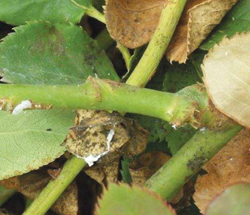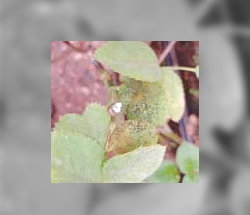 Mealybugs are insects in the family Pseudococcidae and they are found in moist, warm habitat. Many of the common species are in the Pseudococcus and Planococcus genera.
Mealybugs are insects in the family Pseudococcidae and they are found in moist, warm habitat. Many of the common species are in the Pseudococcus and Planococcus genera.
Mealybugs damage plants with their toxic saliva, causing leaves to drop, inhibiting plant growth particularly of new shoots and creating yellow spots. Mealybugs can be difficult to treat because they hide in crevices where stems meet leaves and can reach damaging population levels rather quickly.
Life cycle
The life history of mealybugs varies depending on species. Their development progresses from egg to nymph, to adult. The Females may lay up to 600 eggs that are small, yellow and are a covered by a cottony mass. The long tailed mealy bugs don’t lay eggs but bear live young ones.
The female nymphs pass through three instars with a generation taking as little as one month depending on temperature. The female adults die shortly after laying all the eggs.
The Male nymphs pass through five instars. They don’t feed after the first two instars and their sole purpose is fertilizing the females.
Mealybugs Damage
Once the crawler selects a feeding site, it inserts its piercing & sucking mouthpart and begins feeding on plant sap. While eating, a sticky waste substance is excreted by the insect (commonly called honeydew). This liquid adheres to leaves and provides a medium for sooty mold to colonize and grow. Sooty mould is black and eventually covers leaves and stems. This mold reduces the surface area for photosynthesis, causes aesthetic damage and reduce the crop vigor.
In addition to the sooty mould, plant damage is caused by the mealybugs sucking plant sap and the pests’ toxic saliva, both resulting in distorted plant growth and premature leaf drop as well as inhibiting new shoots growth. Plant leaves also develop yellow chlorotic spots.
Management and Control of Mealybugs.
- Exclusion: It’s important to always inspect any planting material and keep all the infested plants away. This will limit chances of introducing the pest into the growing field or green house.
- Field sanitation: Remove all the crop debris , Crown galls and any other unwanted plant parts that may harbour the pest.
- Nutritional balance: High nitrogen levels will encourage soft growth which attract mealy bugs.
- Use of biological agents.
- Use of pesticides.
-
- Choice of pesticides: Should encourage the survival of the natural enemies.
- Mode of Action: Rotate with different chemistry to reduce chances of resistance build up.
Corteva Agriscience Solutions
At Corteva Agriscience we have a registered new chemistry product that is systemic and targeted at managing Mealybugs and other sap sucking pests on many crops.
Closer 240 SC contains the Active ingredient called Isoclast™ (Sulfoxaflor) and is the sole member of a new chemical class of insecticides, the sulfoximines in the chemical class 4C. It has been developed globally for use in major crop groups, including roses. It controls economically important and difficult-to control sap-feeding insect pests including most species of aphids, mealybugs and whiteflies.
Noteworthy Features
- Effective at low use rates
- Excellent knockdown and residual control
- Excellent translaminar and systemic activity
- Effective against insect pest populations resistant to other insecticides
- Valuable rotation partner with other chemistries.
- Minimal impact on beneficial insects, including bees and natural enemies, when applicators follow label directions for use.
 Mode of Action and Resistance
Mode of Action and Resistance
Available data indicate Isoclast™ active exhibits complex and unique interactions with insect nicotinic acetylcholine receptors (nAChR) that are distinct from those observed with neonicotinoids and other molecules in group 4.
Isoclast is a high efficacy nAChR agonist with low affinity for the neonicotinoids binding site. Numerous studies have been conducted to determine whether insects resistant to other insecticides are cross resistant to Isoclast. Available data for Isoclast indicate a broad lack of cross-resistance in many sap-feeding insect strains resistant to other insecticides. In several field studies, Isoclast controlled insect populations known to be resistant to neonicotinoids and to insecticides with other modes of action (e.g. carbamates, organophosphates, pyrethroids etc).
Because of its unique properties and broad lack of cross-resistance, Isoclast is a useful rotation partner with other insecticide chemistries, enhancing insect resistance management (IRM) strategies.
How Isoclast™ Active Kills Insect Pests
Isoclast™ active kills insect pests both on contact and through ingestion to provide both knockdown and residual control. Isoclast displays both translaminar movement (moves to the opposite leaf surface) and systemic movement when applied to foliage and is xylem-mobile.
Efficacy of Isoclast against Insect Pests
Isoclast provides excellent efficacy against target pests at low use rates. Proposed application rates of Isoclast range from approximately 100 to 120 millilitres of product per hectare depending on the target pest and the crop. Isoclast provides excellent control of many species of sap-feeding insects, including mealybugs, whiteflies and aphids.
Impact of Isoclast™ Active on Natural Enemies of Insect Pests
Isoclast has no significant impact on population levels of any of the natural enemies. In addition, Isoclast has has no impact on beneficial mite species.
Crop Tolerance
Corteva AgriScience has received no reports of any negative plant responses or phytotoxicity from the application of Isoclast. Isoclast™ Active and Non-Target Organisms Isoclast™ active does not persist in the terrestrial environment and degrades rapidly to products that exhibit low toxicity to nontarget organisms.
